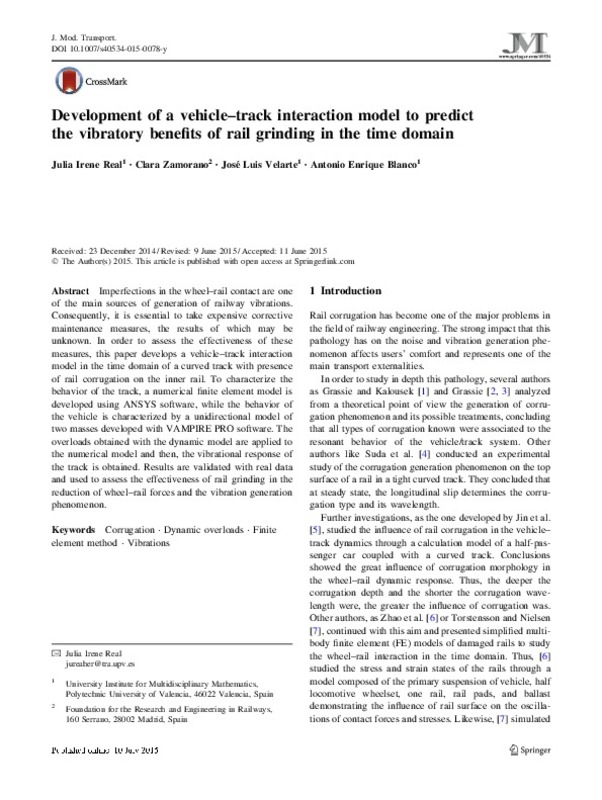Grassie SL, Kalousek J (1993) Rail corrugation: characteristics, causes and treatments. Proc Inst Mech Eng Part F: J Rail Rapid Transit 207:57–68
Grassie SL (2005) Rail corrugation: advances in measurement, understanding and treatment. Wear 258:1224–1234
Grassie SL (2009) Rail corrugation: characteristics, causes and treatments. Proc Inst Mech Eng Part F: J Rail Rapid Transit 223:581–596
[+]
Grassie SL, Kalousek J (1993) Rail corrugation: characteristics, causes and treatments. Proc Inst Mech Eng Part F: J Rail Rapid Transit 207:57–68
Grassie SL (2005) Rail corrugation: advances in measurement, understanding and treatment. Wear 258:1224–1234
Grassie SL (2009) Rail corrugation: characteristics, causes and treatments. Proc Inst Mech Eng Part F: J Rail Rapid Transit 223:581–596
Suda Y, Komine H, Iwasa T, Terumichi Y (2002) Experimental study on mechanism of rail corrugation using corrugation simulator. Wear 253:162–171
Jin XS, Wen ZF, Wang KY, Zhou ZR, Liu QY, Li CH (2006) Three-dimensional train–track model for study of rail corrugation. J Sound Vib 293(3):830–855
Zhao X, Li Z, Esveld C, Dollevoet R (2007) The dynamic stress state of the wheel–rail contact. In: Proceedings of the 2nd IASME/WSEAS international conference on continuum mechanics
Torstensson P, Nielsen J (2011) Simulation of dynamic vehicle-track interaction on small radius curves. Veh Syst Dyn 49(11):1711–1732
Hawari HM, Murray MH (2008) Effects of train characteristics on the rate of deterioration of track roughness. J Eng Mech 134(3):234–239
Ling L, Li W, Shang H, Xiao X, Wen Z, Jin X (2014) Experimental and numerical investigation of the effect of rail corrugation on the behaviour of rail fastenings. Veh Syst Dyn 52(9):1211–1231
Collette C, Horodinca M, Preumont A (2009) Rotational vibration absorber for the mitigation of rail rutting corrugation. Veh Syst Dyn 47:641–659
Egaña J, Viñolas J, Gil-Negrete L (2005) Effect of liquid high positive friction (HPF) modifier on wheel-rail contact and rail corrugation. Tribol Int 38:769–774
Real Herraiz JI, Galisteo Cabeza A, Real T, Zamorano Martin C (2012) Study of wave barriers design for the mitigation of railway ground vibrations. J Vibroeng 14(1):408–422
Real JI, Zamorano C, Hernandez C, Comendador R, Real T (2014) Computational considerations of 3-D finite element method models of railway vibration prediction in ballasted tracks. J Vibroeng 16(4):1709–1722
Andersen L, Jones CJ (2001) Three-dimensional elastodynamic analysis using multiple boundary element domains. ISVR Technical Memorandum, University of Southampton, Southampton
López Pita A (2006) Infraestructuras Ferroviarias. Universitat Politècnica de Catalunya, Barcelona
Alves P, Calçada R, Silva A (2011) Vibrations induced by railway traffic: influence of the mechanical properties of the train on the dynamic excitation mechanism. In: Proceedings of the 8th international conference on structural dynamics, EURODYN 2011, Leuven, Belgium
Ferrara R, Leonardi G, Jourdan F (2012) Numerical modelling of train induced vibrations. In: SIIV-5th international congress—sustainability of road infrastructures, Rome, Italy
Uzzal RU, Ahmed AK, Bhat RB (2013) Modelling, validation and analysis of a three-dimensional railway vehicle–track system model with linear and nonlinear track properties in the presence of wheel flats. Veh Syst Dyn 51(11):1695–1721
Eadie DT, Kalousek J, Chiddick KC (2002) The role of high positive friction (HPF) modifier in the control of short pitch corrugations and related phenomena. Wear 253:185–192
[-]









